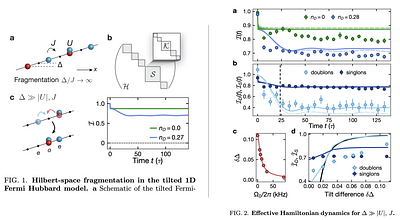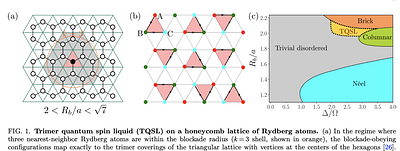By: Thomas Kohlert, Sebastian Scherg, Pablo Sala, Frank Pollmann, Bharath Hebbe Madhusudhana, Immanuel Bloch, Monika Aidelsburger
Quantum many-body systems may defy thermalization even without disorder.
Intriguingly, non-ergodicity may be caused by a fragmentation of the many-body
Hilbert-space into dynamically disconnected subspaces. The tilted
one-dimensional Fermi-Hubbard model was proposed as a platform to realize
fragmented models perturbatively in the limit of large tilt. Here, we
demonstrate the validity of this effective description for the transient
dynamics ... more
Quantum many-body systems may defy thermalization even without disorder.
Intriguingly, non-ergodicity may be caused by a fragmentation of the many-body
Hilbert-space into dynamically disconnected subspaces. The tilted
one-dimensional Fermi-Hubbard model was proposed as a platform to realize
fragmented models perturbatively in the limit of large tilt. Here, we
demonstrate the validity of this effective description for the transient
dynamics using ultracold fermions. The effective analytic model allows for a
detailed understanding of the emergent microscopic processes, which in our case
exhibit a pronounced doublon-number dependence. We study this experimentally by
tuning the doublon fraction in the initial state.
less
By: Milan Kornjača, Rhine Samajdar, Tommaso Macrì, Nathan Gemelke, Sheng-Tao Wang, Fangli Liu
Quantum spin liquids are elusive but paradigmatic examples of strongly
correlated quantum states that are characterized by long-range quantum
entanglement. Recently, the direct signatures of a gapped topological
$\mathbb{Z}_2$ spin liquid have been observed in a system of Rydberg atoms
arrayed on the ruby lattice. Here, we illustrate the concrete realization of a
fundamentally different class of spin liquids in a honeycomb array of Rydberg
... more
Quantum spin liquids are elusive but paradigmatic examples of strongly
correlated quantum states that are characterized by long-range quantum
entanglement. Recently, the direct signatures of a gapped topological
$\mathbb{Z}_2$ spin liquid have been observed in a system of Rydberg atoms
arrayed on the ruby lattice. Here, we illustrate the concrete realization of a
fundamentally different class of spin liquids in a honeycomb array of Rydberg
atoms. Exploring the quantum phase diagram of this system using both
density-matrix renormalization group and exact diagonalization simulations,
several density-wave-ordered phases are characterized and their origins
explained. More interestingly, in the regime where third-nearest-neighbor atoms
lie within the Rydberg blockade radius, we find a novel ground state -- with an
emergent $\mathrm{U}(1)\times \mathrm{U}(1)$ local symmetry -- formed from
superpositions of classical {\it trimer} configurations on the dual triangular
lattice. The fidelity of this trimer spin liquid state can be enhanced via
dynamical preparation, which we explain by a Rydberg-blockade-based projection
mechanism associated with the smooth turnoff of the laser drive. Finally, we
discuss the robustness of the trimer spin liquid phase under realistic
experimental parameters and demonstrate that our proposal can be readily
implemented in current Rydberg atom quantum simulators.
less

